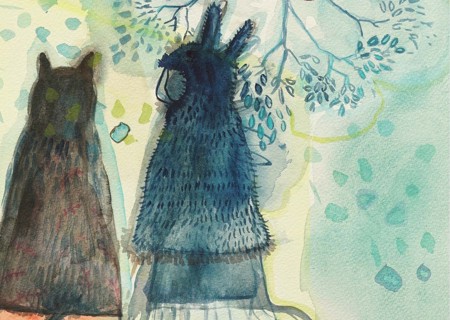On We Go was launched at Bowen Galleries, Wellington, on Monday 15 March by Damien Wilkins.
I’m very happy to say a few words about this gorgeous, strange and bewitching little book of Jane’s elliptical yet open poems and Catherine’s enchanting paintings. These collaborations are tricky things to pull off. You know, poems and pictures . . . Too often it’s like trying to listen to two radios tuned to different stations. Mostly you just want to turn one off. But this combo is totally winning!
‘Fairytale’ feels like the ready-made word for describing the feel of this book. And sure, it’s a bit Moomintrolly in the pictures’ evocation of melancholy and fellowship and loneliness; a bit Where the Wild Things Are in their haunted goofiness, too. Yes, I do think it works a bit like a picture book for grown-ups. And it feels like there’s maybe more story in the pictures than the words, and that’s a good thing. We don’t want words to trample all over these hesitant images. They don’t. The poems are connected to the facing illustrations but also have their own strange lives to live. Imagine them not as glosses or explanations but as paths leading from Catherine’s forests — we follow them to go somewhere else . . .
On We Go it’s called — three two letter words, this simple yet slightly mysterious formulation, with its double sense of an injunction — on we go! Let’s head into the bush! Make art! Make a difference! — but then, that other sense creeps in of — what? — resignation and even doubt — on we go, on and on. As in, maybe we shouldn’t go on as we are. Maybe we should stop, change. And so we’re poised between a sort of rush to do something and the dread that our rushing and doing isn’t getting us very far and might be causing harm. It might seem odd to say the spectre of harm sits in these dreamy forestscapes of bunnies and bunny people but hold on to that thought.
I’ve known Catherine since she was at school with my sister Sarah. And I bought a painting at I think her first show in 1985. It’s called Tiger 2 and in those days Catherine painted in chunky oils on asymmetrical strips of canvas then layered into shapes. The idea that a figurative form — shock, a person — might appear in a Bagnall painting back then would have been like asking Colin McCahon to put in a few people sunbathing when he did a coastline or something.
Anyway, I’ve always liked her work. And this Tiger from all those years ago, I now see, was an animal in disguise — there were no ears or tails or feet or faces — as you get here — but you saw the tiger in these blue stripes against the orange. So although the style is different, it’s still animals and disguises. And there’s still the completely and fiercely independent follow-your-own-nose quality to whatever Catherine does. She’s resolutely herself as a person and artist.
With this new phase of Catherine’ work, I love the combination of tremendous delicacy of the line drawing with that spilled stained quality of watercolour. The paint — uneven, blotchy, shadowy — can refuse the confines of the sketched forms, and this frequently makes fuzzy and spectral what’s happening in the images. So what is happening?
I said before that the pictures have more story than the words. A couple of times, they have words too. And there’s an image near the end with these words, in a thought bubble rising from the solitary figure who is not much more than a blue stain: ‘The wonder and joy of being alive in a world full of other things so alive’ — and you think, oh nice, the full connection with the natural world, but then your eye tracks across to another thought bubble, which says ‘Maybe here I am a pest too’. That’s probably the most explicit this non-explicit work gets. And it’s kind of a downer given the apparent joy on offer, not only in dressing up as animals for walks in the bush but our joy in looking into these pictures. But that’s the necessary edge of critique sharpening the bunny cuteness. We should remember there’s a page given over to one of these figures weeping.
So sorrow is here. Conscience. Correction.
We may wish to be animals and to have their freedoms, and we might even get close to it — there’s a picture of the people opening their arms as if embracing the spirit of the trees — but I’m struck by something else: how Catherine’s people often come to the edge of the forest and are paused, as if they don’t quite know what to do; as if they’ve come to the wrong place, or they’re wrong for the place. The blurb for this book talks about it ‘speaking directly about global warming and the perils facing the natural world’ but the art performance pieces which these glowing pictures record aren’t straightforwardly cautionary and nor are they celebratory once they’re brought back down from the hills and given this form. What I think we end up with are works of great pictorial poise but also moral poise since they seem reticent as well as committed. They haven’t made their mind up — and that’s appealing and provoking. On we go . . .
There’s trouble in the forest of the world and it’s trouble which the poems also sketch: one poem begins: ‘Places of permanent shadow / live here / and hand-sized pieces of fear / mottle day-time things’; another poem concludes; ‘and wrong worlds of dream / unfurl into waking hours / and gleam’. Your looking and reading starts maybe with charm, prettiness, softness, gentleness, bunny rabbits and — and gradually these wrong worlds of dream sneak in and we’re somewhere else entirely . . .


